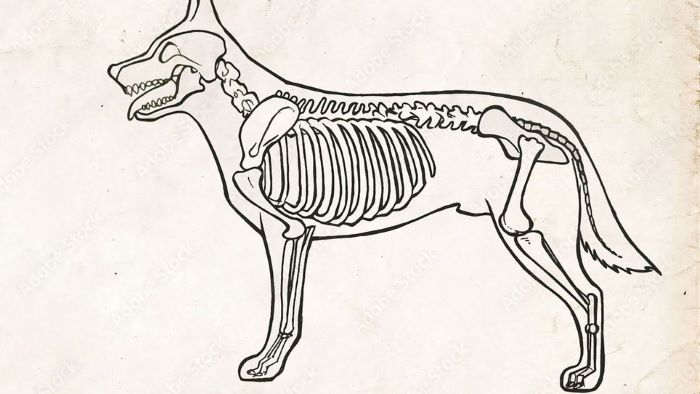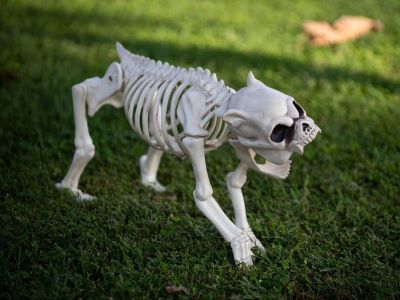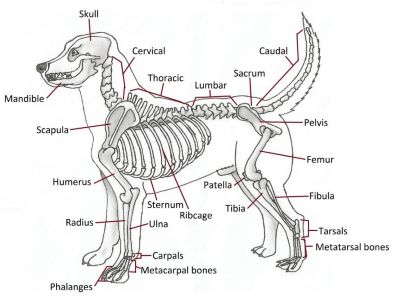Have you ever wondered how many bones your furry friend has in their body?
Dogs’ organs, muscles, and joints are supported and safeguarded by their bones. They also help to improve a dog’s ability to walk, run, play, and carry out other activities.

The number of bones in a dog’s body depends on several factors, such as their breed, size, shape, and function.
In this article, we will explore how many bones does a dog have in their body and how bones vary among dog breeds, how they develop and change throughout a dog’s life, and how to keep them healthy and strong.
Contents
How Many Bones Are There in a Dog’s Body?
Dogs have more bones than humans, dogs have on average between 319 – 321 bones in their body, but this number can vary from 280 to 351.
Bones are classified into different types based on their shape and function, such as long, short, flat, irregular, and sesamoid.
Bones are the framework that supports and protects a dog’s organs, muscles, and joints, and also help them move, run, play, and perform various tasks.

Bones Vary Among Dog Breeds
The breed, size, form, and function of the bones as well as their shape and function determine how many bones a dog has in their body.
Breeds can vary in the number of bones they have, notably in the spine, skull, and limbs.
For example, The quantity of bones in various areas differs depending on whether breeds have longer tails or ears than others.
To identify the bones in a dog’s body, one can use anatomical terms and directions that are specific to dogs.[1]
Examples of breeds with different bone numbers:
- Some breeds have more bones than the average of 321 because they have longer tails or ears that contain more vertebrae or cartilage.
- For example, Irish Setters have 23 tail vertebrae compared to 20 in most dogs.
- Other breeds have fewer bones than the average because they have shorter tails or ears that contain fewer vertebrae or cartilage.
- For example, Bulldogs have 18 tail vertebrae compared to 20 in most dogs.

- Some breeds also have different numbers of bones in their skulls or limbs because of variations in shape and size.
- For example, Pugs have a shorter and flatter skull than most dogs, which affects the number and shape of their cranial bones.
- Another example is Greyhounds, which have longer and thinner limbs than most dogs, which affects the number and shape of their long bones.
How Bones Develop and Change Throughout a Dog’s Life?
Bones grow and fuse during puppyhood and adolescence, which are critical periods for bone health and development.
Bones can be affected by aging, injury, disease, and nutrition, which can cause pain, deformity, fracture, or infection.
Keeping a dog’s bones healthy and strong requires proper diet, exercise, weight management, and veterinary care.[2]
1). Bones Grow and Fuse During Puppyhood and Adolescence

- Bones are composed of living cells that produce a hard matrix of minerals and proteins.
- Bones grow in length by adding new bone tissue at the ends of the bones, where there are specialized regions called growth plates.
- Growth plates are soft and vulnerable to injury or infection, which can affect the shape and length of the bones.
- Growth plates close or fuse when the dog reaches maturity, usually between 6 and 24 months depending on the breed and size.
- Bones also grow in width by adding new bone tissue under the periosteum, which is a thin layer of tissue that covers the bones.
- Bones are constantly remodeled throughout life by breaking down old bone tissue and replacing it with new bone tissue.
This process is influenced by hormones, nutrition, and mechanical stress.
2). The Functions and Types of Bones in a Dog’s Body
The skeleton’s hard tissues, or bones, support and shield the body while also facilitating mobility, storing minerals, and creating blood cells.
Many varieties of bones, including long, short, flat, irregular, and sesamoid, are categorized based on their shape and function.
Many parts of the skeleton contain different types of bones, each of which has a unique structure and function in the body.
The functions and examples of different types of bones in a dog’s body are as follows:
a). Long Bones: Levers for Movement and Blood Cell Production
- Long bones are typical of the limb bones, such as the femur, humerus, radius, ulna, tibia, fibula, metacarpals, metatarsals, and phalanges.
- Long bones have a shaft containing a medullary cavity filled with bone marrow, and two enlarged ends called epiphyses.
- Long bones act as levers for muscular action and movement, and also store minerals and produce blood cells.
b). Flat Bones: Shields for Vital Organs
- Flat bones are thin and broad bones that have an outer layer of compact bone with a layer of cancellous or spongy bone inside.
- Flat bones include the flat bones of the skull, scapula, ribs, sternum, and pelvis.
- Flat bones protect the underlying soft organs of the body, such as the brain, heart, lungs, and reproductive organs.

c). Short Bones: Stabilizers for Joints
- Short bones are cube-shaped bones that have an outer layer of compact bone with a core of cancellous bone .
- Short bones include the carpal and tarsal bones of the wrists and ankles.
- Short bones provide stability and support for the joints of the limbs.[3]
d). Irregular Bones: Supporters and Protectors of Various Body Parts
- Irregular bones are bones that have a complex shape that does not fit into any other category.
- Irregular bones include the vertebrae of the spine, the sacrum, the coccyx, and some bones of the skull such as the sphenoid and ethmoid.
- Irregular bones support and protect various parts of the body, such as the spinal cord, brain, eyes, ears, and nose.
e). Sesamoid Bones: Friction Reducers and Leverage Enhancers for Tendons and Muscles
- Sesamoid bones are small round or oval bones that are embedded within tendons or joint capsules.
- Sesamoid bones include the patella (kneecap) and some small bones in the wrists and ankles.
- Sesamoid bones reduce friction and increase leverage for tendons and muscles around joints.
FAQs
Do dogs have 206 bones?
No, dogs have more bones than humans. Dogs have between 319 to 321 bones in their bodies, depending on their tail length. Humans have 206 bones in their bodies.
How many bones do dogs and cats have?
Dogs and cats have similar numbers of bones in their bodies, but not exactly the same. Dogs have between 319 to 321 bones, depending on their tail length. Cats have between 230 to 250 bones, depending on their tail length and the presence or absence of a dewclaw.
How many bones are in a dogs tail?
The number of bones in a dog’s tail varies depending on the length and shape of the tail. Generally, dogs have between 5 to 23 tail vertebrae. Some breeds have longer tails or ears than others, which affect the number of bones in those regions. Some breeds also have docked or cropped tails, which reduce the number of bones in the tail.
How many bones does a dog leg have?
A dog leg consists of two parts: the thoracic limb (foreleg) and the pelvic limb (hindleg). The thoracic limb has 30 bones and the pelvic limb has 32 bones.
Conclusion
You have learned a lot about a dog’s bones in this article. You have found out how many bones does a dog have in their body, how they grow and change, and what they do for their body.
Bones are essential for a dog’s health and happiness. They support, protect, and enable them to move and play. By taking care of their bones, you can help them enjoy a long and active life.
We hope you liked this article and gained some new insights about your canine companion. If you have any feedback or questions, please let us know. Thanks for reading!
References:
- Bannasch, D. L., Baes, C. F., & Leeb, T. (2020). Genetic Variants Affecting Skeletal Morphology in Domestic Dogs. Trends in Genetics, 36(8), 598–609. – Trends in Genetics
- PetMD Editorial. (2022b). 5 Ways to Strengthen Your Dog’s Bones. – PetMD
- Rlarsen. (n.d.). Pelvic Limb. Pressbooks. Retrieved June 20, 2023, from – University of Minnesota

Julia is a Board Certified Veterinary Nutritionist, practicing veterinarian in a non-profit animal hospital and feline sanctuary located in Rochester, NY. She is also a full-time veterinary advisor at DogLikesBest. She focuses on writing healthcare-related topics including dog foods, treats, veterinary diets, food for specific healthcare features, etc. Moreover, any article on DogNeedsBest that has to concern feline health in any way, goes under her scrutiny before being published.

